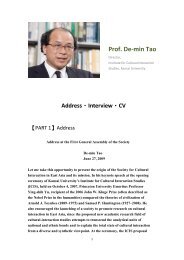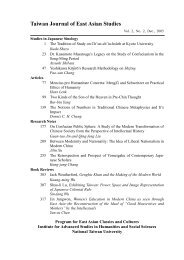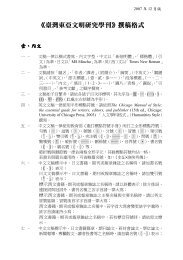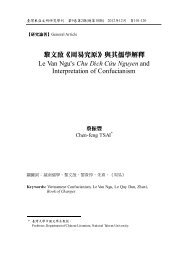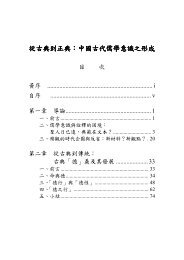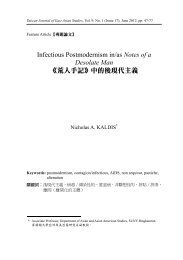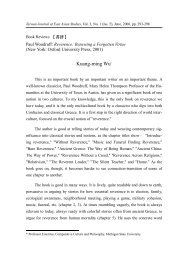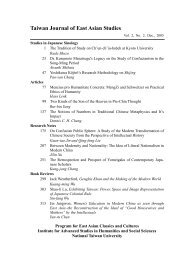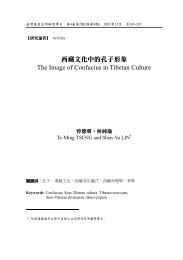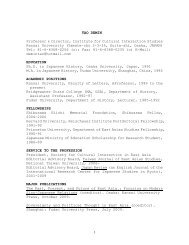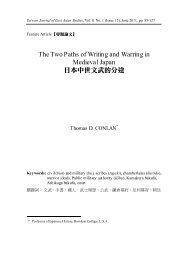臺灣東亞文明研究學刊 - 東亞經典與文化研究計畫 - 國立臺灣大學
臺灣東亞文明研究學刊 - 東亞經典與文化研究計畫 - 國立臺灣大學
臺灣東亞文明研究學刊 - 東亞經典與文化研究計畫 - 國立臺灣大學
Create successful ePaper yourself
Turn your PDF publications into a flip-book with our unique Google optimized e-Paper software.
Jeng-Guo CHEN Scottish Discussions of Indian Effeminacy in the Eighteenth Century 157<br />
of a man. The fair-sex, who have commonly much more tenderness than ours, have<br />
seldom so much generosity." 11<br />
Smith's celebrated pupil at Glasgow, John Millar (1735-1801), fully integrated<br />
this gendered change into the four stage theory of history. Millar pointed out that,<br />
from the hindsight of history, "the disuse of the feudal militia was an immediate<br />
consequence of the progress of people in arts and manufactures." 12 And he also<br />
pointed out that the progress of civilization kept strict pace with women's increased<br />
participation in society and improved virtue. From Millar's liberal point of view,<br />
civilization, commerce and feminization ran a parallel course. This theoretical<br />
grounding would not have presented any principled complaints about Hindu<br />
effeminacy, but one suspects that theory and principle worked far better when<br />
grappling with distant realities than when an effeminate culture threatened the<br />
nearer neighborhood.<br />
In fact, many British writers approached polite culture with some misgivings.<br />
Gibbon, who liked to describe himself as half Scots, worried that women's<br />
increased power in the dominion of manners would inevitably lead to "softness of<br />
the mind." 13 Adam Ferguson (1723-1816), a highland Scots and stout exponent of<br />
civic virtue, initiated the reaction against the too submissive character of the Hindu<br />
nation. The subject came up in one of his discussions of the national militia, a<br />
favorite topic. Ferguson believed that the republican virtues inculcated by service in<br />
the militia could serve as antidote for the corrupting influence of commercial<br />
luxury. He followed closely Montesquieu's theory of the union of effeminacy and<br />
despotism. More importantly, India, Hinduism, indeed, was exemplified as an<br />
archetypical model of the kind.<br />
11 Adam Smith, Theory of Moral Sentiments (Oxford: Oxford University Press, 1976), pp. 190-191.<br />
12 John Millar, The Origin of the Distinction of Ranks: An Inquiry into the Circumstances which Give<br />
Rise to Influence and Authority in the Different Members of Society (Bristol: Thoemmes, 1990,<br />
c1806), p. 224.<br />
13 John G. A. Pocock, "The Mobility of Property and the Rise of Eighteenth-Century Sociology," in<br />
Virtue, Commerce and History (Cambridge: Cambridge University Press, 1985), p. 118.<br />
ix



